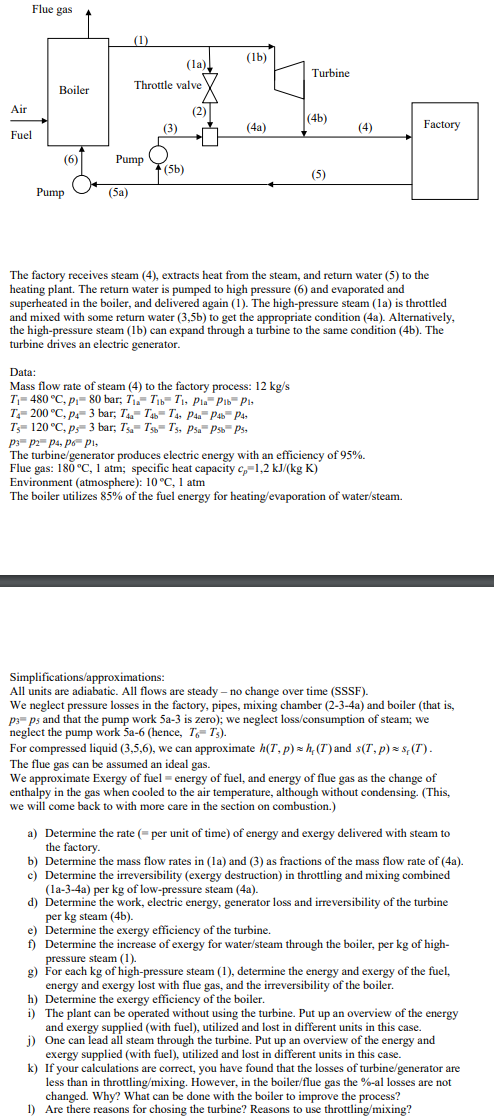
The factory receives steam (4), extracts heat from the steam, and return water (5) to the heating plant. The return water is pumped to high pressure (6) and evaporated and superheated in the boiler, and delivered again (1). The high-pressure steam (1a) is throttled and mixed with some return water (3,5b) to get the appropriate condition (4a). Alternatively, the high-pressure steam ( 1b) can expand through a turbine to the same condition (4b). The turbine drives an electric generator. Data: Mass flow rate of steam (4) to the factory process: 12kg/s T1=480C,p1=80bar;T1a=T1b=T1,p1a=p1b=p1,T4=200C,p4=3bar;T4a=T4b=T4,p4a=p4b=p4,T5=120C,p5=3bar;T5a=T5b=T5,p5a=p5b=p5,p3=p2=p4,p6=p1, The turbine/generator produces electric energy with an efficiency of 95%. Flue gas: 180C,1atm; specific heat capacity cp=1,2kJ/(kgK) Environment (atmosphere): 10C,1atm The boiler utilizes 85% of the fuel energy for heating/evaporation of water/steam. Simplifications/approximations: All units are adiabatic. All flows are steady - no change over time (SSSF). We neglect pressure losses in the factory, pipes, mixing chamber (2-3-4a) and boiler (that is, p3=p5 and that the pump work 5a3 is zero); we neglect loss/consumption of steam; we neglect the pump work 5a-6 (hence, T6=T5 ). For compressed liquid (3,5,6), we can approximate h(T,p)hf(T) and s(T,p)sf(T). The flue gas can be assumed an ideal gas. We approximate Exergy of fuel = energy of fuel, and energy of flue gas as the change of enthalpy in the gas when cooled to the air temperature, although without condensing. (This, we will come back to with more care in the section on combustion.) a) Determine the rate (= per unit of time) of energy and exergy delivered with steam to the factory. b) Determine the mass flow rates in (1a) and (3) as fractions of the mass flow rate of (4a). c) Determine the irreversibility (exergy destruction) in throttling and mixing combined (1a-3-4a) per kg of low-pressure steam (4a). d) Determine the work, electric energy, generator loss and irreversibility of the turbine per kg steam (4b). e) Determine the exergy efficiency of the turbine. f) Determine the increase of exergy for water/steam through the boiler, per kg of highpressure steam (1). g) For each kg of high-pressure steam (1), determine the energy and exergy of the fuel, energy and exergy lost with flue gas, and the irreversibility of the boiler. h) Determine the exergy efficiency of the boiler. i) The plant can be operated without using the turbine. Put up an overview of the energy and exergy supplied (with fuel), utilized and lost in different units in this case. j) One can lead all steam through the turbine. Put up an overview of the energy and exergy supplied (with fuel), utilized and lost in different units in this case. k) If your calculations are correct, you have found that the losses of turbine/generator are less than in throttling/mixing. However, in the boiler/flue gas the \%-al losses are not changed. Why? What can be done with the boiler to improve the process? 1) Are there reasons for chosing the turbine? Reasons to use throttling / mixing







